Influence of Cement Thickness on the Polymerization Shrinkage Stress of Adhesively Cemented Composite Inlays: Photoelastic and Finite Element Analysis
Abstract
1. Introduction
2. Materials and Methods
3. Results
4. Discussion
5. Conclusions
Author Contributions
Funding
Institutional Review Board Statement
Informed Consent Statement
Data Availability Statement
Conflicts of Interest
References
- Diaz-Arnold, A.M.; Vargas, M.A.; Haselton, D.R. Current status of luting agents for fixed prosthodontics. J. Prosthet. Dent. 1999, 81, 135–141. [Google Scholar] [CrossRef]
- de Matos, J.D.; Nakano, L.J.; Bottino, M.A.; de Jesus, R.H.; Maciel, L.C. Current considerations for dental ceramics and their respective union systems. Rev. Bras. Odontol. 2020, 77, e1768. [Google Scholar] [CrossRef]
- Menezes-Silva, R.; Velasco, S.R.; BRESCIANi, E.; Bastos, R.D.; Navarro, M.F. A prospective and randomized clinical trial evaluating the effectiveness of ART restorations with high-viscosity glass-ionomer cement versus conventional restorations with resin composite in Class II cavities of permanent teeth: Two-year follow-up. J. Appl. Oral Sci. 2021, 29, e20200609. [Google Scholar] [CrossRef]
- Ernst, C.P.; Meyer, G.R.; Klöcker, K.; Willershausen, B. Determination of polymerization shrinkage stress by means of a photoelastic investigation. Dent. Mater. 2004, 20, 313–321. [Google Scholar] [CrossRef]
- Charton, C.; Falk, V.; Marchal, P.; Pla, F.; Colon, P. Influence of Tg, viscosity and chemical structure of monomers on shrinkage stress in light-cured dimethacrylate-based dental resins. Dent. Mater. 2007, 23, 1447–1459. [Google Scholar] [CrossRef]
- Weinmann, W.; Thalacker, C.; Guggenberger, R. Siloranes in dental composites. Dent. Mater. 2005, 21, 68–74. [Google Scholar] [CrossRef]
- Feilzer, A.J.; De Gee, A.J.; Davidson, C.L. Increased wall-to-wall curing contraction in thin bonded resin layers. J. Dent. Res. 1989, 68, 48–50. [Google Scholar] [CrossRef]
- De Jager, N.; Pallav, P.; Feilzer, A.J. The influence of design parameters on the FEA-determined stress distribution in CAD-CAM produced all-ceramic dental crowns. Dent. Mater. 2005, 21, 242–251. [Google Scholar] [CrossRef]
- Ionescu, A.C.; Cazzaniga, G.; Ottobelli, M.; Ferracane, J.L.; Paolone, G.; Brambilla, E. In vitro biofilm formation on resin-based composites cured under different surface conditions. J. Dent. 2018, 77, 78–86. [Google Scholar] [CrossRef] [PubMed]
- Ozyesil, A.G.; Usumez, A.; Gunduz, B. The efficiency of different light sources to polymerize composite beneath a simulated ceramic restauration. J. Prosthet. Dent. 2004, 91, 151–157. [Google Scholar] [CrossRef]
- Arrais, C.A.; Rueggeberg, F.A.; Waller, J.L.; de Goes, M.F.; Giannini, M. Effect of curing mode on the polymerization characteristics of dual-cured resin cement systems. J. Dent. 2008, 36, 418–426. [Google Scholar] [CrossRef]
- Marinho, M.L.; Strazzi-Sayhon, H.B.; Moraes, J.C.; Assunção, W.G.; Dos Santos, P.H. Degree of conversion of resin cements polymerized under different ceramic systems. Gen. Dent. 2020, 68, 44–49. [Google Scholar] [PubMed]
- Rullman, I.; Patyna, M.; Janssen, B.; Willershausen, B. Determination of polymerization shrinkage of different composites using a photoelastic method. Am. J. Dent. 2017, 30, 16–22. [Google Scholar] [PubMed]
- Rullmann, I.; Schattenberg, A.; Marx, M.; Willershausen, B.; Ernst, C.P. Photoelastic determination of polymerization shrinkage stress in low-shrinkage resin composites. Schweiz. Mon. Zahnmed. 2012, 122, 294–299. [Google Scholar]
- Schwertner, A.; Almeida, R.R.; Gonini, A., Jr.; Almeida, M.R. Photoelastic analysis of stress generated by Connecticut Intrusion Arch (CIA). Dent. Press J. Orthod. 2017, 22, 57–64. [Google Scholar] [CrossRef][Green Version]
- Kainose, K.; Nakajima, M.; Foxton, R.; Wakabayashi, N.; Tagami, J. Stress distribution in root filled teeth restored with various post and core techniques: Effect of post length and crown height. Int. Endod. J. 2015, 48, 1023–1032. [Google Scholar] [CrossRef]
- da Silva, J.V.; Martins, T.A.; Noritomi, P.Y. Scaffold informatics and biomimetic design: Three-dimensional medical reconstruction. Methods Mol. Biol. 2012, 868, 91–109. [Google Scholar] [PubMed]
- Kinomoto, Y.; Torii, M.; Takeshige, F.; Ebisu, S. Polymerization contraction stress of resin composite restorations in a model class I cavity configuration using photoelastic analysis. J. Esthet. Restor. Dent. 2000, 12, 309–319. [Google Scholar] [CrossRef] [PubMed]
- Correia, A.; Andrade, M.R.; Tribst, J.; Borges, A.; Caneppele, T. Influence of bulk-fill restoration on polymerization shrinkage stress and marginal gap formation in Class V restorations. Oper. Dent. 2020, 45, E207–E216. [Google Scholar] [CrossRef] [PubMed]
- Versluis, A.; Tantbirojn, D.; Pintado, M.R.; DeLong, R.; Douglas, W.H. Residual shrinkage stress distributions in molars after composite restoration. Dent. Mater. 2004, 20, 554–564. [Google Scholar] [CrossRef]
- Borges, A.L.; Borges, A.B.; Xavier, T.A.; Bottino, M.C.; Platt, J.A. Impact of quantity of resin, C-factor, and geometry on resin composite polymerization shrinkage stress in Class V restorations. Oper. Dent. 2014, 39, 144–151. [Google Scholar] [CrossRef]
- Noritomi, P.; Xavier, T.; Silva, J. A comparison between BioCAD and some known methods for finite element model generation. In Innovative Developments in Virtual and Physical Prototyping; CRC Press: Boca Raton, FL, USA, 2011; pp. 685–690. ISBN 9780415684187. [Google Scholar]
- Campaner, L.M.; Silveira, M.P.; de Andrade, G.S.; Borges, A.L.; Bottino, M.A.; Dal Piva, A.M.; Lo Giudice, R.; Ausiello, P.; Tribst, J.P. Influence of polymeric restorative materials on the stress distribution in posterior fixed partial dentures: 3D finite element analysis. Polymers 2021, 13, 758. [Google Scholar] [CrossRef] [PubMed]
- de Andrade, G.S.; Pinto, A.B.; Tribst, J.P.; Chun, E.P.; Borges, A.L.; de Siqueira Ferreira Anzaloni Saavedra, G. Does overlay preparation design affect polymerization shrinkage stress distribution? A 3D FEA study. Comput. Methods Biomech. Biomed. Eng. 2021, 1–10. [Google Scholar] [CrossRef] [PubMed]
- Ausiello, P.P.; Ciaramella, S.; Lanzotti, A.; Ventre, M.; Borges, A.L.; Tribst, J.P.; Dal Piva, A.; Garcia-Godoy, F. Mechanical behavior of Class I cavities restored by different material combinations under loading and polymerization shrinkage stress. A 3D-FEA study. Am. J. Dent. 2019, 32, 55–60. [Google Scholar] [PubMed]
- Scotti, N.; Coero Borga, F.A.; Alovisi, M.; Rota, R.; Pasqualini, D.; Berutti, E. Is fracture resistance of endodontically treated mandibular molars restored with indirect onlay composite restorations influenced by fibre post insertion? J. Dent. 2012, 40, 814–820. [Google Scholar] [CrossRef] [PubMed]
- Kassis, C.; Khoury, P.; Mehanna, C.Z.; Baba, N.Z.; Bou Chebel, F.; Daou, M.; Hardan, L. Effect of Inlays, Onlays and Endocrown Cavity Design Preparation on Fracture Resistance and Fracture Mode of Endodontically Treated Teeth: An In Vitro Study. J. Prosthodont. 2020. [Google Scholar] [CrossRef]
- Abad-Coronel, C.; Naranjo, B.; Valdiviezo, P. Adhesive systems used in indirect restorations cementation: Review of the literature. Dent. J. 2019, 7, 71. [Google Scholar] [CrossRef] [PubMed]
- Collares, K.; Corrêa, M.B.; Laske, M.; Kramer, E.; Reiss, B.; Moraes, R.R.; Huysmans, M.C.; Opdam, N.J. A practice-based research network on the survival of ceramic inlay/onlay restorations. Dent. Mater. 2016, 32, 687–694. [Google Scholar] [CrossRef]
- D’Arcangelo, C.; Vanini, L.; Casinelli, M.; Frascaria, M.; De Angelis, F.; Vadini, M.; D’Amario, M. Adhesive cementation of indirect composite inlays and onlays: A literature review. Compend. Contin. Educ. Dent. 2015, 36, 570–577, quiz 578. [Google Scholar] [PubMed]
- Yoshihara, K.; Nagaoka, N.; Sonoda, A.; Maruo, Y.; Makita, Y.; Okihara, T.; Irie, M.; Yoshida, Y.; Van Meerbeek, B. Effectiveness and stability of silane coupling agent incorporated in ‘universal’ adhesives. Dent. Mater. 2016, 32, 1218–1225. [Google Scholar] [CrossRef]
- Kim, J.Y.; Cho, G.Y.; Roh, B.D.; Shin, Y. Effect of curing mode on shear bond strength of self-adhesive cement to composite blocks. Materials 2016, 9, 210. [Google Scholar] [CrossRef] [PubMed]
- Dal Piva, A.M.; Tribst, J.P.; Jalkh, E.B.; Anami, L.C.; Bonfante, E.A.; Bottino, M.A. Minimal tooth preparation for posterior monolithic ceramic crowns: Effect on the mechanical behavior, reliability and translucency. Dent. Mater. 2021, 37, e140–e150. [Google Scholar] [CrossRef] [PubMed]
- Gomes de Carvalho, A.B.; de Andrade, G.S.; Mendes Tribst, J.P.; Grassi, E.D.; Ausiello, P.; Saavedra, G.D.; Bressane, A.; Marques de Melo, R.; Borges, A.L. Mechanical behavior of different restorative materials and onlay preparation designs in endodontically treated molars. Materials 2021, 14, 1923. [Google Scholar] [CrossRef] [PubMed]
- Ferracane, J.L.; Mitchem, J.C. Relationship between composite contraction stress and leakage in Class V cavities. Am. J. Dent. 2003, 16, 239–243. [Google Scholar] [PubMed]
- Kaisarly, D.; Gezawi, M.E. Polymerization shrinkage assessment of dental resin composites: A literature review. Odontology 2016, 104, 257–270. [Google Scholar] [CrossRef]
- da Rosa, H.C.; Marcondes, M.L.; de Souza, N.C.; Weber, J.B.; Spohr, A.M. Do resin cements influence the cuspal deflection of teeth restored with composite resin inlays? Acta Odontol. Latinoam. 2015, 28, 28–34. [Google Scholar]
- Salaverry, A.; Borges, G.A.; Mota, E.G.; Burnett Júnior, L.H.; Spohr, A.M. Effect of resin cements and aging on cuspal deflection and fracture resistance of teeth restored with composite resin inlays. J. Adhe. Dent. 2013, 15, 561–568. [Google Scholar]
- Dall Agnol, R.J.; Ghiggi, P.C.; Paranhos, M.P.; Borges, G.A.; Burnett, L.H., Jr.; Spohr, A.M. Influence of resin cements on cuspal deflection and fracture load of endodontically-treated teeth restored with composite inlays. Acta Odontol. Scand. 2013, 71, 664–670. [Google Scholar] [CrossRef]
- Sokolowski, G.; Krasowski, M.; Szczesio-Wlodarczyk, A.; Konieczny, B.; Sokolowski, J.; Bociong, K. The influence of cement layer thickness on the stress state of metal inlay restorations-photoelastic analysis. Materials 2021, 14, 599. [Google Scholar] [CrossRef]
- Braga, R.R.; Boaro, L.C.; Kuroe, T.; Azevedo, C.L.; Singer, J.M. Influence of cavity dimensions and their derivatives (volume and “C” factor) on shrinkage stress development and microleakage of composite restorations. Dent. Mater. 2006, 22, 818–823. [Google Scholar] [CrossRef]
- Hayashi, J.; Shimada, Y.; Tagami, J.; Sumi, Y.; Sadr, A. Real-time imaging of gap progress during and after composite polymerization. J. Dent. Res. 2017, 96, 992–998. [Google Scholar] [CrossRef]
- Ilie, N.; Jelen, E.; Clementino-Luedemann, T.; Hickel, R. Low-shrinkage composite for dental application. Dent. Mater. J. 2007, 26, 149–155. [Google Scholar] [CrossRef]
- Watts, D.C.; Satterthwaite, J.D. Axial shrinkage-stress depends upon both C-factor and composite mass. Dent. Mater. 2008, 24, 1–8. [Google Scholar] [CrossRef] [PubMed]
- Craig, R.G.; el-Ebrashi, M.K.; LePeak, P.J.; Peyton, F.A. Experimental stress analysis of dental restorations. I. Two-dimensional photoelastic stress analysis of inlays. J. Prosthet. Dent. 1967, 17, 277–291. [Google Scholar] [CrossRef]
- Feilzer, A.J.; De Gee, A.J.; Davidson, C.L. Setting stress in composite resin in relation to configuration of the restoration. J. Dent. Res. 1987, 66, 1636–1639. [Google Scholar] [CrossRef] [PubMed]
- Sakaguchi, R.; Powers, J. Restorative Materials. In Craig’s Restorative Dental Materials; Elsevier: Amsterdam, The Netherlands, 2019; pp. 135–170. ISBN 9780323478212. [Google Scholar]
- Rodrigues, F.P.; Silikas, N.; Watts, D.C.; Ballester, R.Y. Finite element analysis of bonded model Class I “restorations” after shrinkage. Dent. Mater. 2012, 28, 123–132. [Google Scholar] [CrossRef] [PubMed]
- de Oliveira Correia, A.M.; Tribst, J.P.; de Souza Matos, F.; Platt, J.A.; Caneppele, T.M.; Borges, A.L. Polymerization shrinkage stresses in different restorative techniques for non-carious cervical lesions. J. Dent. 2018, 76, 68–74. [Google Scholar] [CrossRef] [PubMed]
- Tribst, J.P.; Dal Piva, A.M.; de Melo, R.M.; Borges, A.L.; Bottino, M.A.; Özcan, M. Short communication: Influence of restorative material and cement on the stress distribution of posterior resin-bonded fixed dental prostheses: 3D finite element analysis. J. Mech. Behav. Biomed. Mater. 2019, 96, 279–284. [Google Scholar] [CrossRef] [PubMed]
- Kaisarly, D.; El Gezawi, M.; Nyamaa, I.; Rösch, P.; Kunzelmann, K.H. Effects of boundary condition on shrinkage vectors of a flowable composite in experimental cavity models made of dental substrates. Clin. Oral Investig. 2019, 23, 2403–2411. [Google Scholar] [CrossRef]
- Dal Piva, A.O.; Tribst, J.P.; Borges, A.L.; de Melo, R.M.; Bottino, M.A. Influence of substrate design for in vitro mechanical testing. J. Clin. Exp. Dent. 2019, 11, e119–e125. [Google Scholar] [CrossRef]
- Benazzi, S.; Nguyen, H.N.; Kullmer, O.; Hublin, J.J. Exploring the bio mechanics of taurodontism. J. Anat. 2015, 226, 180–188. [Google Scholar] [CrossRef] [PubMed]
- Al-Harbi, F.; Kaisarly, D.; Bader, D.; El Gezawi, M. Marginal integrity of bulk versus incremental fill class II composite restorations. Oper. Dent. 2016, 41, 146–156. [Google Scholar] [CrossRef] [PubMed]
- Li, J.; Li, H.; Fok, S.L. A mathematical analysis of shrinkage stress development in dental composite restorations during resin polymerization. Dent. Mater. 2008, 24, 923–931. [Google Scholar] [CrossRef] [PubMed]
- Tribst, J.P.; Dal Piva, A.M.; Ausiello, P.; Kalman, L. Influence of implant-abutment contact surfaces and prosthetic screw tightening on the stress concentration, fatigue life and microgap formation: A finite element analysis. Oral 2021, 1, 88–101. [Google Scholar] [CrossRef]
- Yeo, H.W.; Loo, M.Y.; Alkhabaz, M.; Li, K.C.; Choi, J.J.; Barazanchi, A. Bulk-fill direct restorative materials: An in vitro assessment of their physio-mechanical properties. Oral 2021, 1, 75–87. [Google Scholar] [CrossRef]
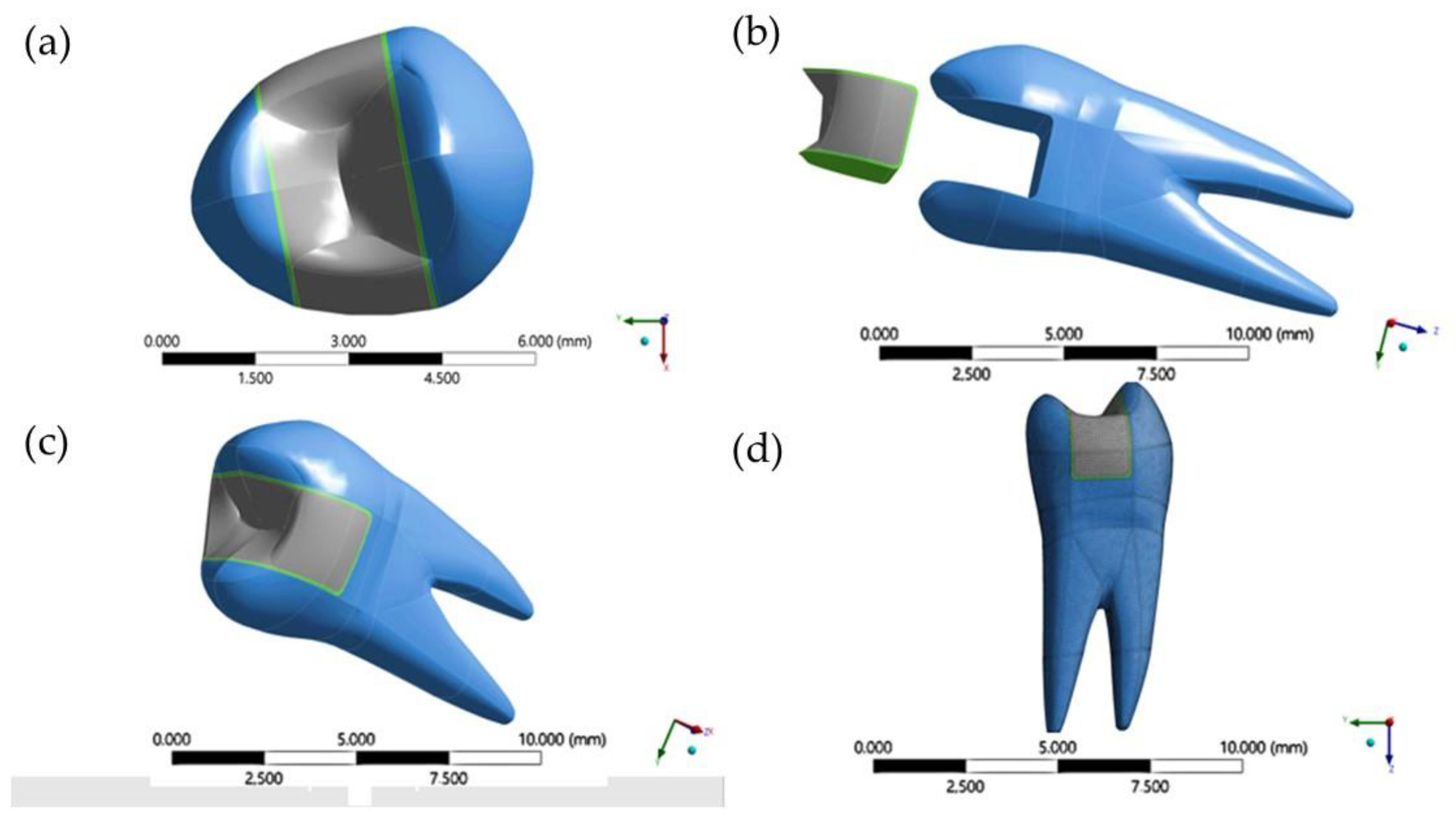
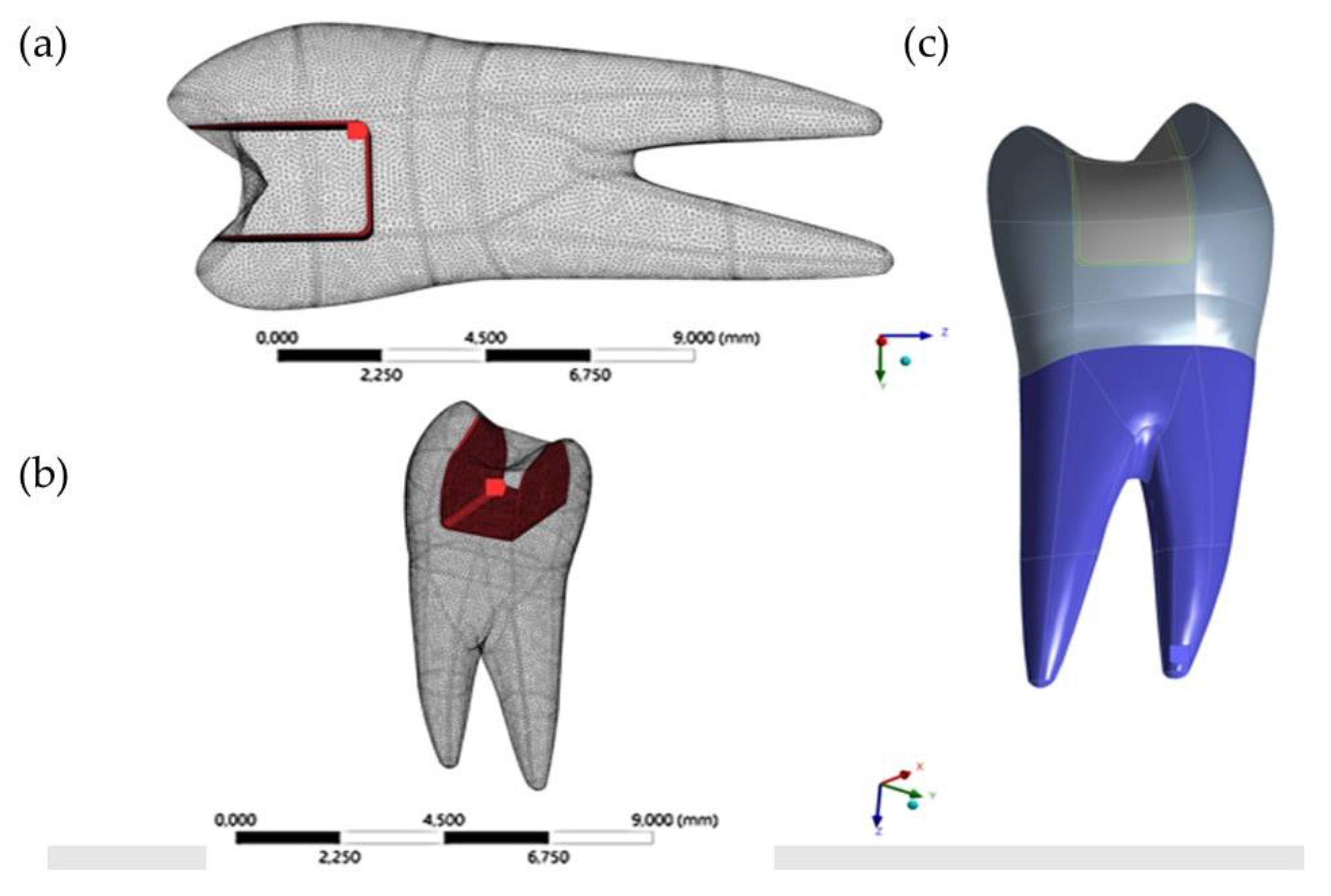
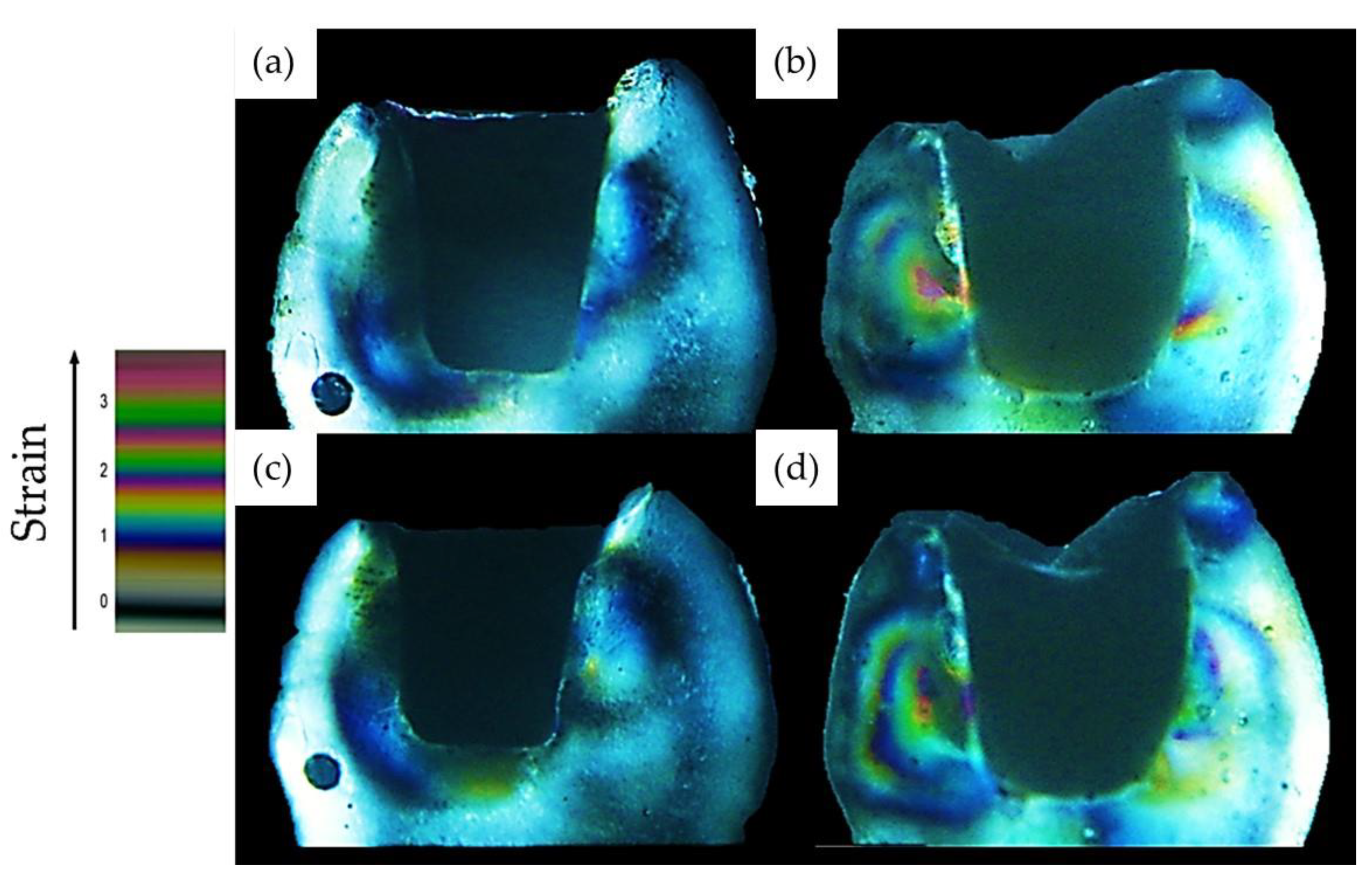

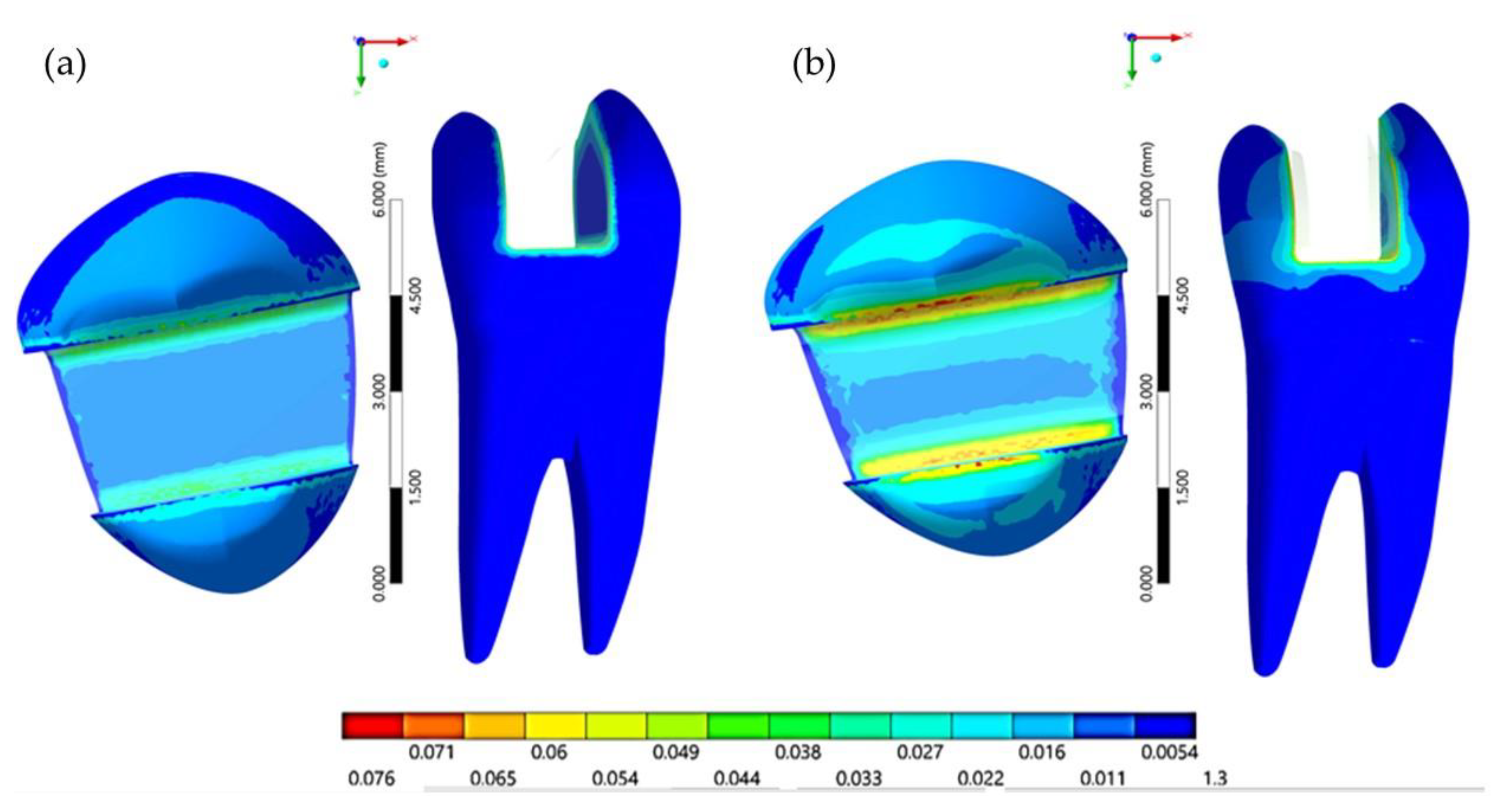
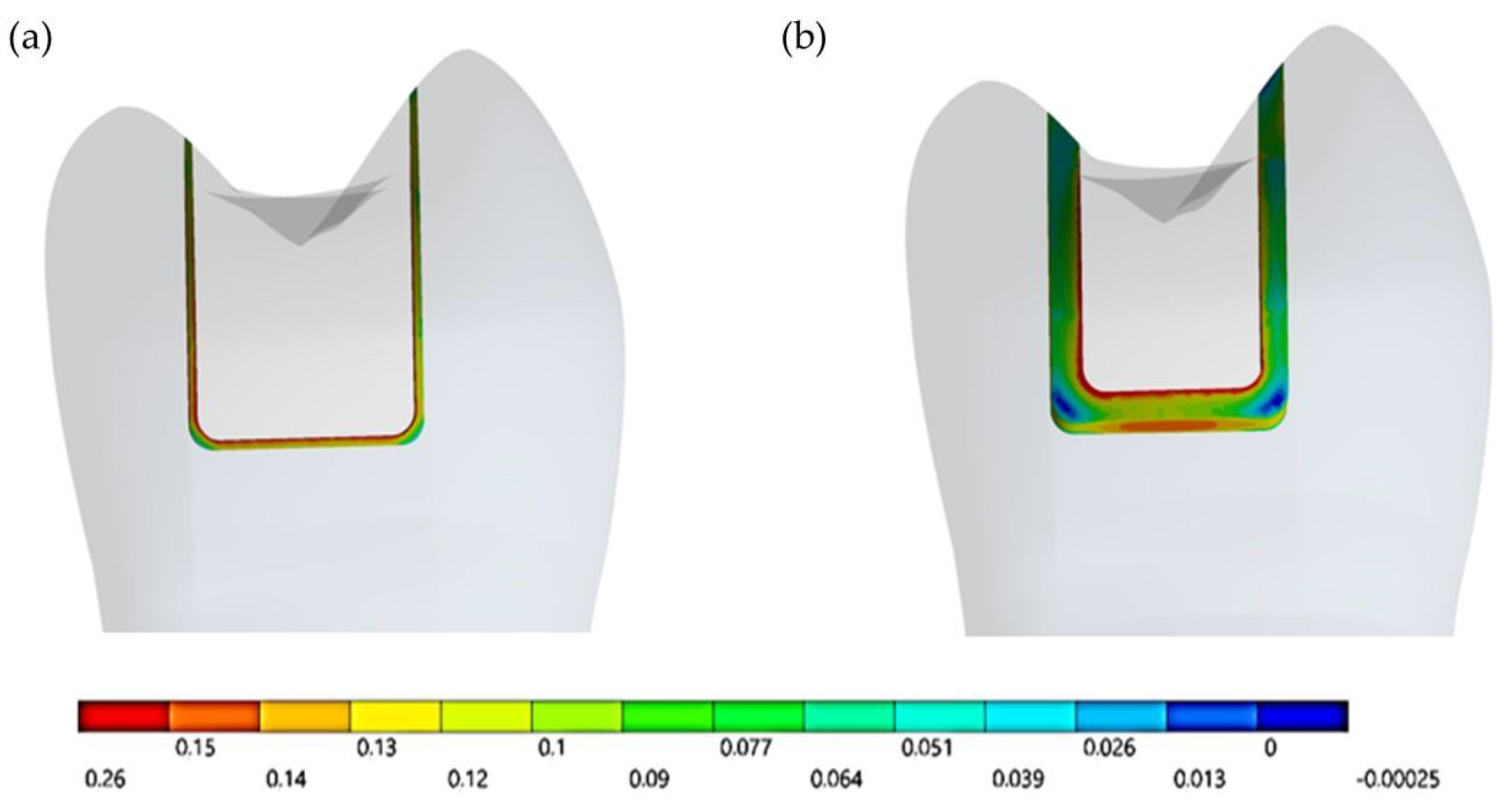

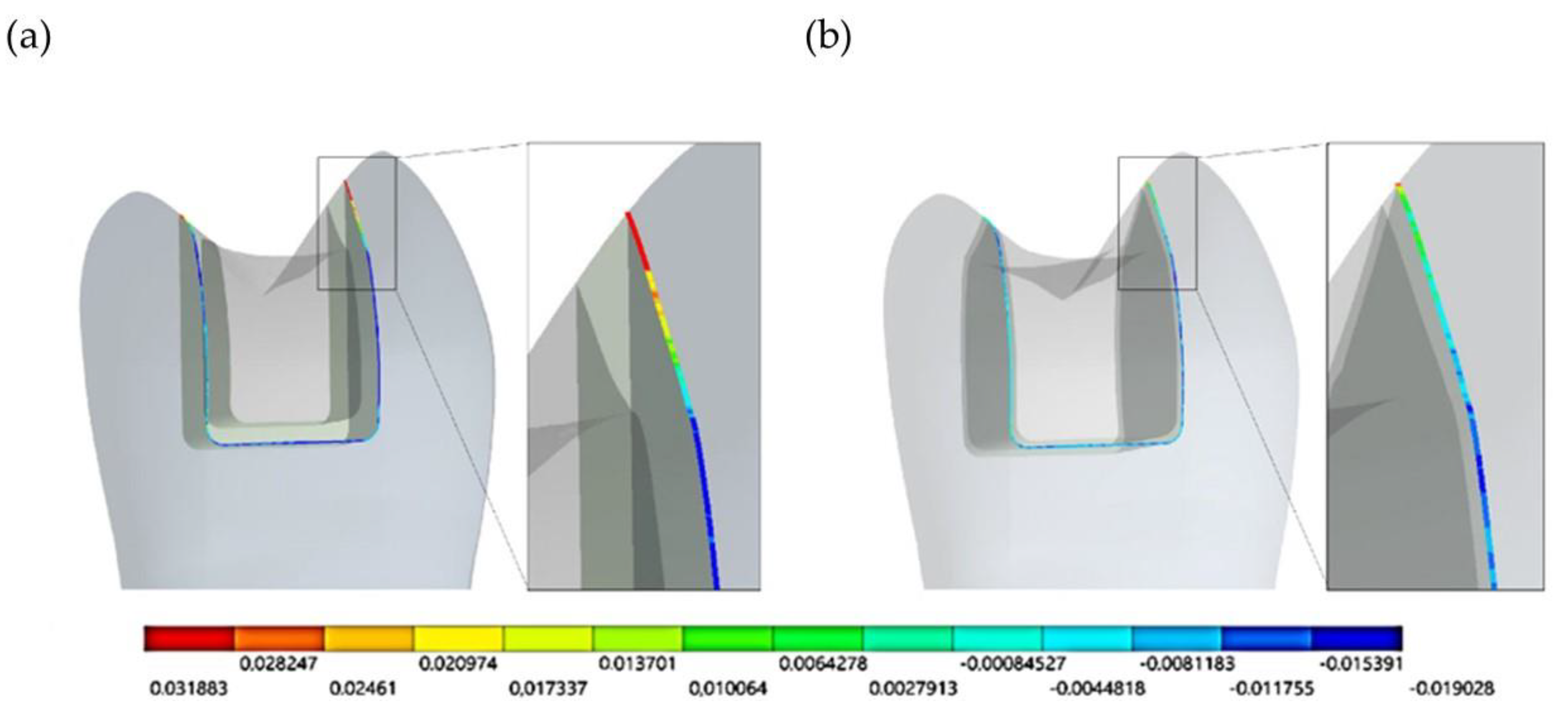
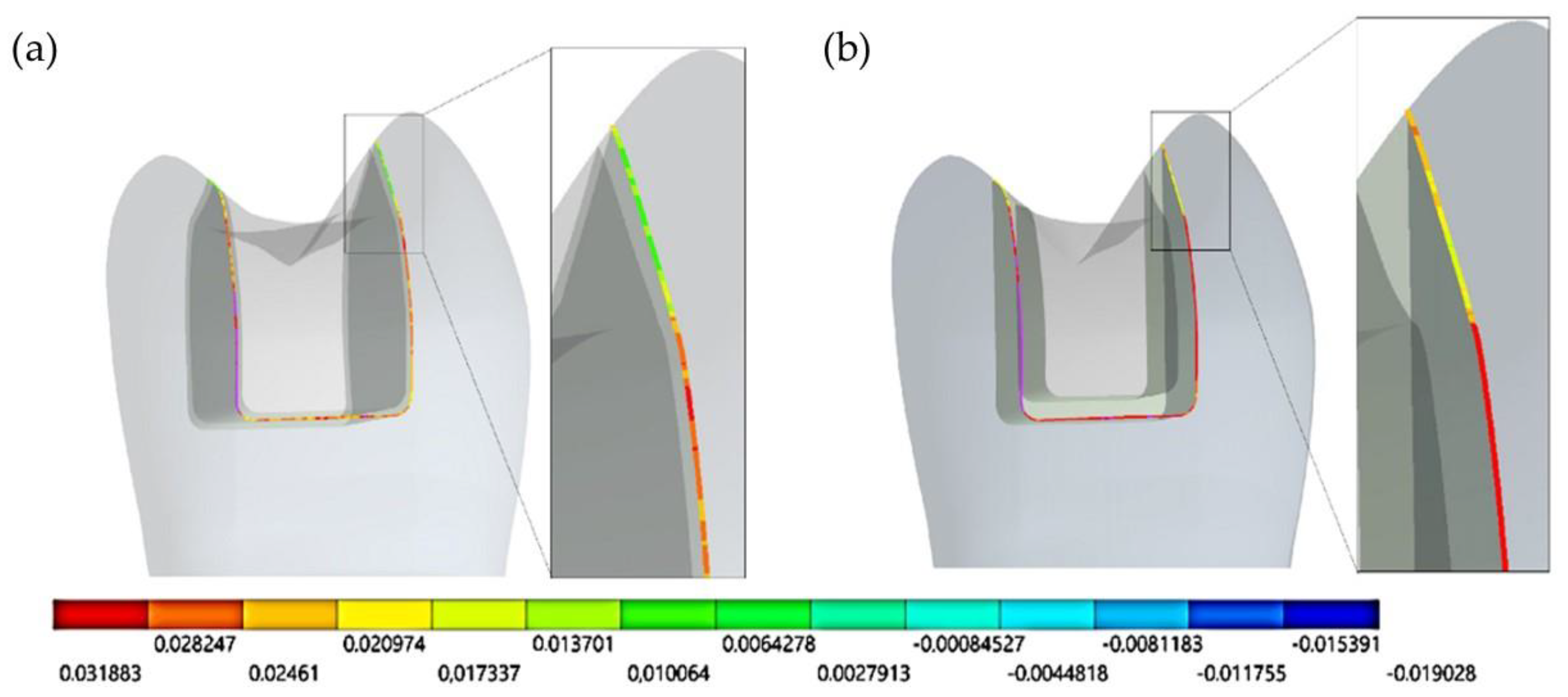
| Material | Young’s Modulus (GPa) | Poisson’s Ratio | Volumetric Shrinkage (%) | References |
|---|---|---|---|---|
| Dentin | 18.0 | 0.23 | - | [18] |
| Enamel | 80.0 | 0.30 | - | [18] |
| Cement layer | 7.0 | 0.24 | 1.74 | [19] |
| Composite resin | 20 | 0.20 | - | [20] |
| Result | Cement Layer Model | |
|---|---|---|
| 100 μm | 400 μm | |
| Cusp displacement (mm) | 0.000107 | 0.00026 |
| Tooth stress (MPa) | 0.210 | 0.305 |
| Cement stress (MPa) | 0.261 | 0.270 |
| Restoration stress (MPa) | 0.203 | 0.270 |
Publisher’s Note: MDPI stays neutral with regard to jurisdictional claims in published maps and institutional affiliations. |
© 2021 by the authors. Licensee MDPI, Basel, Switzerland. This article is an open access article distributed under the terms and conditions of the Creative Commons Attribution (CC BY) license (https://creativecommons.org/licenses/by/4.0/).
Share and Cite
Campaner, L.M.; Alves Pinto, A.B.; Demachkia, A.M.; Paes-Junior, T.J.d.A.; Pagani, C.; Borges, A.L.S. Influence of Cement Thickness on the Polymerization Shrinkage Stress of Adhesively Cemented Composite Inlays: Photoelastic and Finite Element Analysis. Oral 2021, 1, 168-180. https://doi.org/10.3390/oral1020017
Campaner LM, Alves Pinto AB, Demachkia AM, Paes-Junior TJdA, Pagani C, Borges ALS. Influence of Cement Thickness on the Polymerization Shrinkage Stress of Adhesively Cemented Composite Inlays: Photoelastic and Finite Element Analysis. Oral. 2021; 1(2):168-180. https://doi.org/10.3390/oral1020017
Chicago/Turabian StyleCampaner, Larissa Mendes, Alana Barbosa Alves Pinto, Amir Mohidin Demachkia, Tarcísio José de Arruda Paes-Junior, Clóvis Pagani, and Alexandre Luiz Souto Borges. 2021. "Influence of Cement Thickness on the Polymerization Shrinkage Stress of Adhesively Cemented Composite Inlays: Photoelastic and Finite Element Analysis" Oral 1, no. 2: 168-180. https://doi.org/10.3390/oral1020017
APA StyleCampaner, L. M., Alves Pinto, A. B., Demachkia, A. M., Paes-Junior, T. J. d. A., Pagani, C., & Borges, A. L. S. (2021). Influence of Cement Thickness on the Polymerization Shrinkage Stress of Adhesively Cemented Composite Inlays: Photoelastic and Finite Element Analysis. Oral, 1(2), 168-180. https://doi.org/10.3390/oral1020017







